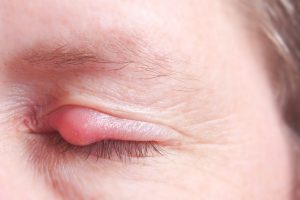
Both conditions usually don’t cause complications. They require minimal treatment and will go away on their own. However, if you notice changes in your stye or chalazion, seek out medical attention to prevent complications.
Chalazion vs. stye: Signs and symptoms
The most obvious sign of a chalazion is a lump on the upper or lower eyelid. Other signs and symptoms include a tender spot on the eyelid, a hard lump you have not seen before, increased tearing of the eyes, blurred or blocked vision, and sensitivity to light.
Symptoms of a stye include a red lump on the eyelid similar to a pimple or boil, eyelid pain, eyelid swelling, and tearing.
Difference between chalazion and stye – causes and risk factors
As chalazion is caused by the gland blockage, it could be associated with the following:
- Poor eyelid hygiene
- Rosacea
- Chronic blepharitis
- High blood lipid concentration (possible risk from increased blockage of sebaceous glands)
- Leishmaniasis
- Tuberculosis
- Viral infection
- Immunodeficiency
- Eyelid surgery
- Eyelid trauma
- Stress (causality not proven)
- Carcinoma
- Trachoma
- Seborrheic dermatitis
The main cause of a stye is a bacterial infection of the oil glands in the eyelid. The bacteria responsible for this infection is staphylococcus.
Risk factors for a stye include touching your eyes with unwashed hands, wearing dirty contact lenses (when you don’t disinfect them or put them in with dirty hands), leaving eye makeup on overnight, using old or expired cosmetics, having chronic inflammation of the eyelid (blepharitis), and having rosacea.
Diagnosing chalazion vs. stye
In many cases, your doctor will be able to diagnose a chalazion by simply looking at the lump on your eyelid. They will take into account your symptoms for a more accurate diagnosis. There are no specific tests for diagnosing a chalazion.
Similar to diagnosing a chalazion, your doctor will most likely be able to diagnose a stye by simply looking at the eye and examining the eyelid.
Treatment options for chalazion and stye
Here are some remedies you can try at home if you spot a chalazion on your eyelid:
- Apply warm compresses
- Massage the eyelid to speed up drainage
- Place clean and warm guava leaves on the eye
- Make a solution with acacia leaves and apply it to the eye
- Mix apple cider vinegar with warm water and soak a cotton ball to place on the eye
- Use a cotton swab to put on castor oil to the area
- Apply green tea bags to the eye
- Cut open aloe vera leaves and place on the eyelid
- Boil parsley and use the water on the eyelids
- Always maintain proper hygiene: wash your wash, don’t touch your eyes with dirty hands, and protect your eyes from dirt and pollution.
A stye will often clear up on its own. If not, your doctor may prescribe antibiotic eye drops. If medication doesn’t help either, your doctor will cut open the stye to drain the pus and promote healing.
To manage your stye at home, avoid touching it, clean your eyelid, place a warm washcloth over the eye a few times a day, keep your eye clean, don’t wear makeup while you have a stye, and avoid wearing contact lenses until it clears up.